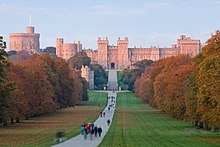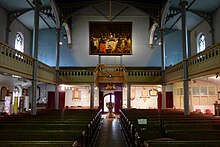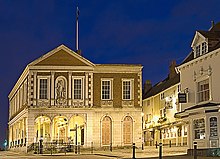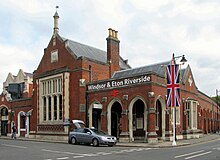Windsor, Berkshire
This article needs additional citations for verification. (September 2012) |
| Windsor | |
|---|---|
| Town | |
 Windsor Bridge, Windsor and Windsor Castle | |
Location within Berkshire | |
| Population | 32,608 (2018 est.) |
| OS grid reference | SU965765 |
| Unitary authority | |
| Ceremonial county | |
| Region | |
| Country | England |
| Sovereign state | United Kingdom |
| Post town | Windsor |
| Postcode district | SL4 |
| Dialling code | 01753 |
| Police | Thames Valley |
| Fire | Royal Berkshire |
| Ambulance | South Central |
| UK Parliament | |
Windsor is a historic town in the Royal Borough of Windsor and Maidenhead in Berkshire, England. It is the site of Windsor Castle, one of the official residences of the British monarch. The town is situated 21.8 miles (35.1 km) west of Charing Cross, central London, 5.8 miles (9.3 km) southeast of Maidenhead, and 15.8 miles (25.4 km) east of the modern county town of Reading. It is immediately south of the River Thames, which forms its boundary with its smaller, ancient twin town of Eton. The village of Old Windsor, just over 2 miles (3 km) to the south, predates what is now called Windsor by around 300 years. In the past, Windsor was formally referred to as New Windsor to distinguish the two.[a]
Etymology
Windlesora is first mentioned in the Anglo-Saxon Chronicle. (The settlement had an earlier name but this is unknown.) The name originates from old English Windles-ore or winch by the riverside.[1][2][3] By 1110, meetings of the Great Council, which had previously taken place at Windlesora, were noted as taking place at the castle, referred to as New Windsor.[dubious ] By the late 12th century the settlement at Windelsora had been renamed Old Windsor.
History












Medieval period
The early history of the site is unknown, although it was almost certainly[dubious ] settled some years before 1070 when William the Conqueror had a timber motte-and-bailey castle constructed.[3] The focus of royal interest at that time[when?] was not the castle, however, but a small riverside settlement about 3 miles (4.8 km) downstream, possibly established from the 7th century. From about the 8th century, high status people as well as the royalty began visiting the site. From the 11th century the site's link with King Edward the Confessor is documented. In the later medieval period, royal use of the site increased, probably because it offered good access to woodlands and opportunities for hunting – a sport which also developed military skills.
Plantagenet period
The settlement at
The town was the site of the Treaty of Windsor in the year 1175, following the Normans invasion of Ireland. The treaty was between Henry II and Ruadhrí Ua Conchobhair, High King of Ireland. The treaty involved agreements regarding the two kings' respective spheres of influence on the island of Ireland, control over their subjects, and the paying of tribute to Henry. Despite the agreement, the treaty would collapse and conflict in Ireland would continue for several centuries.[5][6]
The town of New Windsor, as an ancient
Windsor's position as chief town of Berkshire was short-lived, however, as people found it difficult to reach. Wallingford took over this position in the early 14th century. As a self-governing town Windsor enjoyed a number of freedoms unavailable to other towns, including the right to hold its own borough court, the right of membership (or 'freedom') and some financial independence. The town accounts of the 16th century survive in part, although most of the once substantial borough archive dating back to the 12th century was destroyed, probably in the late 17th century.
New Windsor was a nationally significant town in the
The development of the castle continued in the late 15th century with the rebuilding of
Tudor and Stuart periods
With the closures of the
Most accounts of Windsor in the 16th and 17th centuries talk of its poverty, badly made streets and poor housing. Shakespeare's play The Merry Wives of Windsor is set in Windsor and contains many references to parts of the town and the surrounding countryside. Shakespeare must have walked the town's streets, near the castle and river Thames, much as people still do. The play may have been written in the Garter Inn, opposite the Castle, but this was destroyed by fire in the late 17th century. The long-standing – and famous – courtesan of king Charles II, Nell Gwyn, was given a house on St Albans Street: Burford House (now part of the Royal Mews). Her residence in this house, as far as it is possible to tell, was brief. Only one of her letters addressed from Burford House survives: it was probably intended as a legacy for her illegitimate son, the Earl of Burford, later the Duke of St Albans.
Windsor was
But his successors did not use the place, and as the town was short of money, the planned new civic buildings did not appear. The town continued in poverty until the mid 19th century. In 1652 the largest house in Windsor Great Park was built on land which Oliver Cromwell had appropriated from the Crown. Now known as Cumberland Lodge after the Duke of Cumberland's residence there in the mid-18th century, the house was variously known as Byfield House, New Lodge, Ranger's Lodge, Windsor Lodge and Great Lodge.[7]
Georgian and Victorian periods
In 1778, there was a resumption of the royal presence, with
A number of fine houses were built in this period, including Hadleigh House on Sheet Street, which was built in 1793 by the then mayor of Windsor, William Thomas. In 1811 it was the home of John O'Reilly, the apothecary-surgeon to
The substantial redevelopment of the castle in the subsequent decade and Queen Victoria's residence from 1840, as well as the coming of two railways in 1849, signalled the most dramatic changes in the town's history. These events catapulted the town from a sleepy medieval has-been to the centre of empire – many European crowned heads of state came to Windsor to visit the Queen throughout the rest of the 19th century. Unfortunately, excessive redevelopment and 'refurbishment' of Windsor's medieval fabric at this time resulted in widespread destruction of the old town, including the demolition of the old parish church of St John the Baptist in 1820. The original had been built around 1135.
Later periods
Most of the current town's streets date from the mid to late 19th century.
Religion
The original
In 1818 the high cost of repairs to the old building led to plans for a complete rebuild at a cost of £14,000. Charles Hollis was appointed architect and the new building was erected between 1820 and 1822 with cast iron columns that were floated down the Thames. The ribs that support the roof are also cast iron. The new church,
The more recent church of All Saints' is situated on Frances Road. The incumbent vicar is the Revd Canon Sally Lodge.[10] The author Thomas Hardy trained as an architect and joined Arthur Blomfield's practice as assistant architect in April 1862. Between 1862 and 1864 he worked with Blomfield on All Saints'.[11] A reredos, possibly designed by Hardy, was discovered behind panelling at All Saints' in August 2016.[12][13]
Tourism
As a result of the castle, Windsor is a popular tourist destination and has facilities usually found in larger towns: two railway stations, a theatre and several substantial hotels. Various boat trips operate on the River Thames, with connections to
Shopping
As a tourist town there are many gift shops around the castle, and there are shops and restaurants in Windsor Royal Station[15] inside Windsor & Eton Central railway station. The main shopping street is Peascod Street.[16]
Transport
Windsor has two railway stations.
Bus services in the town are provided by
Windsor has links to three local motorways:
- the M3 (junction 3), 10 miles (16 km) to the south via the A332, passing Ascot;
- the M4 (junction 6), 3 miles (5 km) to the north via the A332, with the A355 spur leading to Slough;
- the M25 (junction 13), 5 miles (8 km) to the east via the A308, which continues to Staines-upon-Thames.
Sport
Windsor's senior
Education
State schools
State-funded schooling in the town is provided by a system of three-tier schooling. Schools are controlled by either the local authority or academy trusts. The town is served by eleven first schools for children up to 9 years old, and three middle schools until age 13.
Pupils aged 13–18 can elect to attend the town's two single-sex secondary schools: The Windsor Boys' School and Windsor Girls' School.
Independent schools
Several independent schools operate in the town, including:
Local media
Since the town is close to London, television signals are received from the Crystal Palace TV transmitter, placing Windsor in the BBC London and ITV London areas.
Local radio stations are
The town's local newspaper is the Windsor Express.
Politics
Windsor is part of the Royal Borough of Windsor and Maidenhead which is administered by an elected unitary authority. The mayor is Councillor Neil Knowles,[23] The current Member of Parliament for the Windsor constituency (which includes the surrounding small towns and villages, such as Eton and Datchet) is Adam Afriyie (Conservative), who was first elected at the 2005 General Election. Afriyie is notable for being the first black Conservative Member of Parliament in the House of Commons. In 2012 the council reintroduced the role of town crier to the borough. The previous town crier had retired in 1892 and for 120 years the post remained vacant. The current crier is Chris Brown[24]
In 2018 the belongings of homeless people were controversially removed and stored for reasons of security.[25] A bus intended to shelter the Windsor homeless was impounded by police.[26]
Twin towns
Windsor is twinned with:
 Goslar, Lower Saxony, Germany (since 1969)
Goslar, Lower Saxony, Germany (since 1969) Neuilly-sur-Seine, Hauts-de-Seine, France (since 1955)
Neuilly-sur-Seine, Hauts-de-Seine, France (since 1955)
Notable residents
Windsor has had many notable residents.
- King Charles III and other British royal family members
- Bruce Anstey, New Zealand motorcycle racer; previously lived in Windsor[27]
- Sir Dhunjibhoy Bomanji, shipping magnate, socialite and philanthropist lived in Windsor[citation needed]
- Zinzan Brooke, New Zealand rugby union international; formerly played amateur rugby for Windsor Rugby Football Club[citation needed]
- Sir Michael Caine, actor; lived at the Old Mill House, Clewer[28]
- Sir Sydney Camm, designer of the World War II fighter aircraft the Hawker Hurricane, lived at 10 Alma Road; a memorial in the form of a replica Hawker Hurricane is displayed near Alexandra Gardens, on the Thames Promenade[29]
- Billy Connolly, comedian; lived in Windsor for several years in the 1990s
- Elizabeth Counsell, actress; born in Windsor[citation needed]
- Richard Fairbrass and Fred Fairbrass, singers from Right said Fred live in Windsor[30]
- Ranulph Fiennes, adventurer, explorer and author; born in Windsor
- Dhani Harrison, musician and son of George Harrison; born in Windsor
- Rugby Union player; born in Windsor[31]
- Chip Hawkes; born in Windsor
- Natalie Imbruglia, Australian pop singer; owns a house in the Clewer village area of Windsor
- Norman Lovett, stand-up comedian and actor best known, as an actor, for playing Holly, the ship's computer, in the TV series Red Dwarf; born in Windsor
- Cambridge Universitydon; born in Windsor
- Margaret Oliphant, 19th century novelist and historical writer; lived at Clarence Crescent
- Chelseaand England footballer; born and resided for many years in Windsor
- Jeremy Kyle, television presenter, lives in Windsor
- Jimmy Page, musician, lived at the Old Mill House at the end of Mill Lane, Windsor 1980-2004[32]
- Princess Margaret to The Beatles; he sold his St. Leonard's Hill guest house to comedian Freddie Starr; and later lived in Ascot Place, which is now apartments and has a plaque and statue dedicated to him[citation needed]
- Jim Swire, doctor best known for his involvement in the aftermath of the 1988 bombing of Pan Am Flight 103[33]
- Hugh Thomas, historian; born in Windsor[34]
Notes and references
- ^ Local government legislation in the 1970s referred to the borough as "New Windsor"
- ^ "The Online Etymology Dictionary". Etymonline.com. Retrieved 3 February 2012.
- ^ "A Brief History of Windsor". Thamesweb.co.uk. Retrieved 3 February 2012.
- ^ ISBN 0-86023-038-4
- ^ "A Guide to the Parish Church of St. John the Baptist, Windsor". Thamesweb.co.uk. Retrieved 3 February 2012.
- ^ "Treaty of Windsor". britanicca.com.
- .
- ^ "Cumberland Lodge: A History". Archived from the original on 21 November 2011.
- ^ Stoughton, John (1862). Windsor: A History and Description of the Castle and the Town. Ward. pp. 176–.
- ^ a b c d e "St John the Baptist Windsor – History". Official website. Retrieved 23 July 2017.
- ^ "New Windsor: All Saints, Windsor". A Church Near You.
- ISBN 9780230378278– via Google Books.
- ^ Flood, Alison (16 August 2016). "Thomas Hardy altarpiece discovered in Windsor church". The Guardian. Retrieved 17 August 2016.
- ^ "Legendary author Thomas Hardy's lost contribution to Windsor church uncovered". Royal Borough Observer.
- ^ Windsor On Ice 2012 | Home Archived 25 December 2012 at the Wayback Machine. Windsoronice.com. Retrieved on 17 July 2013.
- ^ Windsor Royal Station Archived 19 January 2021 at the Wayback Machine windsorroyalstation.co.uk
- ^ King Edward Court Archived 11 August 2017 at the Wayback Machine windsor-shopping.co.uk
- ^ "The Railways at Windsor – The Royal Windsor Web Site History Zone". thamesweb.co.uk. Retrieved 31 May 2015.
- ^ "CONFIRMED: Two bus companies step up to save axed services in Slough and Windsor". Royal Borough Observer. 12 January 2018. Retrieved 21 January 2019.
- ^ "National Public Transport Information – from traveline SE & anglia". travelinesoutheast.org.uk.
- ^ "Coach Park". rbwm.gov.uk. Retrieved 24 January 2021.
- ^ https://www.radioroadhouseuk.com/
- ^ "Royal Borough Radio".
- ^ "The Mayoralty | Royal Borough of Windsor and Maidenhead".
- ^ Windsor and Maidenhead Town Crier Town Crier Windsor and Maidenhead – Chris Brown Archived 4 April 2013 at the Wayback Machine. Windsortowncrier.com. Retrieved on 17 July 2013.
- ^ "Homeless people in Windsor have belongings removed to be stored ahead of the Royal Wedding". iNews. 16 May 2018. Retrieved 18 May 2018.
- ^ "Homeless refuge bus seized by police in Windsor ahead of Royal wedding". Evening Standard. London. Retrieved 18 May 2018.
- ^ "Bruce Almighty". www.motorcyclenews.com.
- ISBN 978-1-904034-82-7. Retrieved 13 June 2021.
- ^ "Windsor Hurricane". Sir Sydney Camm Commemorative Society.
- ^ "RSF RECORDINGS LIMITED". Companies House. 27 June 2012. Retrieved 17 April 2023.
- ^ "James Haskell". ESPN. Retrieved 28 December 2020.
- ISBN 9781423404071.
- ^ "Biographical details". Lockerbietruth.com. Retrieved 17 October 2022.
- ^ Cowell, Alan (11 May 2017). "Hugh Thomas, Prodigious Author of Spanish History, Dies at 85". The New York Times. p. B14. Retrieved 15 May 2017.
- ISBN 9783030264215.
- ^ "H. G. Wells". open plaques. Retrieved 12 January 2021.
External links
 Media related to Windsor, Berkshire at Wikimedia Commons
Media related to Windsor, Berkshire at Wikimedia Commons
- Windsor at Curlie

